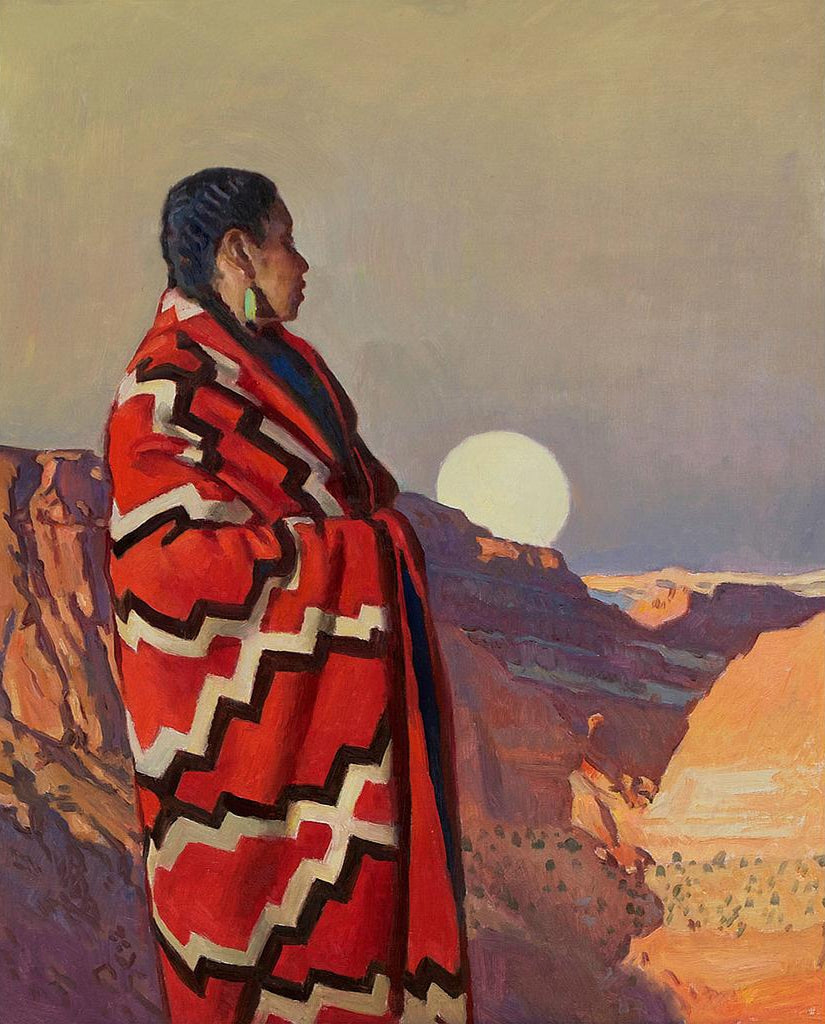Ray Roberts: Woven in Time
By Medicine Man Gallery on

A new Ray Roberts exhibition at Medicine Man Gallery celebrates Native American weavings and figures.
By John O’Hern
Published online courtesy Western Art Collector, July 2018
Ray Roberts is equally at home in the moist atmosphere of the Pacific Coast and in the dry desert air of the Southwest. He and his artist wife, Peggi, live on a 20-acre “ranchette” in an old California gold rush town. He was brought up in Orange County when it was still mostly orange groves, but after the untimely death of his father and the illness of his mother he was sent to the Orme School in the Arizona desert, a ranch—style boarding school with a strong arts program.

Ray Roberts - Moonrise, oil on mounted linen, 30 by 24 inches
He says, “Over the years I've become my own artist. I'm constantly searching and evolving. When I go out to paint, whether it’s on the coast, the mountains or the desert, I look for something that speaks to me emotionally, and try to get that communication across. I hope that people can share my vision through the canvas. My paintings are my footprints.”

He and Peggi spent their early careers in illustration but both painted on the side. They showed at outdoor art fairs and, in 1992, made their move to creating fine art exclusively.
Roberts is drawn to a strong sense of design, a characteristic of the woven blankets and rugs of the Navajo. Since he had been painting Native figures draped in blankets in various Southwest settings, Mark Sublette suggested he do a series of paintings of models in blankets from his Medicine Man Gallery collection. The result, an exhibition called Blanket Talk, will open at the Tucson, Arizona, gallery July 13 and continue through July 31.
A signature painting is Council Meeting, with three elders gathered in the shade, wrapped in blankets and conducting the business of their pueblo.

Ray Roberts - Rim Watcher, oil on mounted linen, 30 by 40 inches
Many of the paintings are women gazing out over the vastness of the desert or the canyons. In View from the Rim, the model wears a third phase chief's blanket, the colors and forms of which echo the Grand Canyon beyond.
"From my background in illustration,” Roberts says, ’’I became fascinated by the design quality of the great illustrators like NC. Wyeth, the shapes, the color and the geometry. They were pure design. The great illustrators of Moonrise, oil on linen mounted on board, 30 x 24" the past are now considered to be fine artists."
He wants viewers of his isolated figures in the landscape ”to put themselves in that spot, to see what the subject is seeing, to share the experience and to be reflective. The desert is so stark, so quiet and so isolated, it’s remarkable how introspective you can get. You feel like you're part of time. You can see it in the time it took for a river to carve a canyon. It's humbling how short our time is in comparison—how small we are in comparison.”

He explains, “I’m very intuitive. I'm searching for those moments that I can paint and that I can share. I don't spend time thinking about it. I get a gut feeling about how the light hits the way a blanket is draped across the figure. Light on the water has always entranced me,” he continues. “It’s a primal force. I let the paintings speak to me. I have a general idea of where I'm going and have a huge library of images to draw from. Working on a painting I get a sense of the direction I want to go. I try to respond to it and let it guide me. I try to bring it together in a single statement. I try to find its essence and to make it graphic and iconic.
“With the figure in the landscape,” he says, “it seems to put me in a place where I can think about a particular spot and about man and woman in nature—about our place in the world. I’m a very earthbound person. It’s such a blessing to have this experience of nature and to hold a great value for the surroundings and for other people."
In another painting, Desert Vision, a shamanic figure stands among designs as if they are appearing to her before she records them on the stones behind her. "Among my favorite artists is Gustav Klimt," he says. “I was always intrigued by the geometric shapes, the design and ephemeral quality of the patterns surrounding his figures. It occurred to me years ago that I could integrate that into my own paintings and I've done it for decades. There is a time between sleep and awakeness when I might come up with an idea. Young Native American men and women took part in vision quests and entered into trances to interact with the spirit world. She represents the shaman.”

Ray Roberts - Desert Vision, oil on canvas, 30 by 24 inches